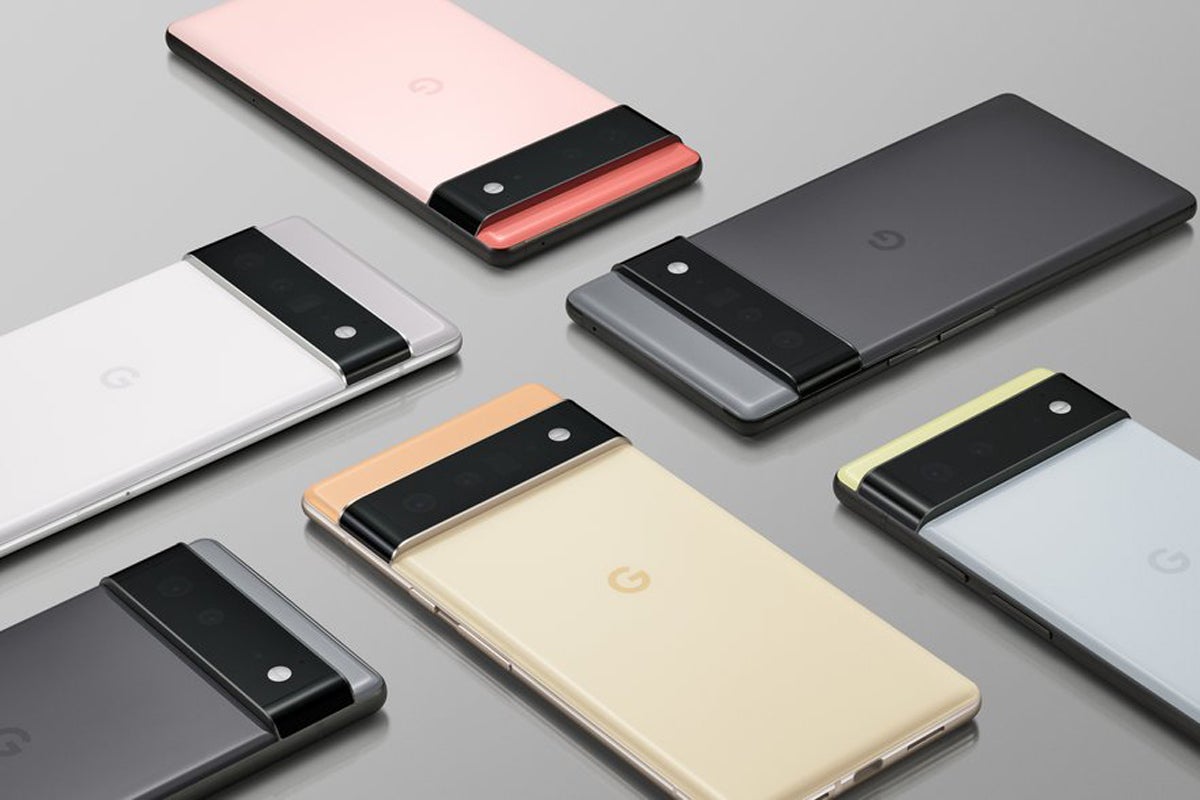Well, gang, it looks like the brightly colored cat is out of the metaphorical bag.
You know what I'm talkin' about, right? The feline in question is none other than Google's Pixel 6 phone — two of 'em, actually. Google pulled off its new favorite trick and let the air out of the rapidly leaking balloon by announcing its Pixel 6 and Pixel 6 Pro months ahead of the devices' actual debuts. Take that, interweb rumor-mongers!
And these new Pixels are pretty different from Pixels past, too. As had been widely expected, they're the first Google-made phones to feature a Google-made processor — a distinction we've been talking about 'round these parts for quite a while now and one that could go a long way in separating the phones from the rest of the Android pack. Google's got a carefully orchestrated campaign spread across several websites to show off some of the practical advantages that new setup will allow, so I won't waste your time rehashing what you've already read.
Here, I want to focus on four underemphasized effects of the Pixel 6 preview — a combination of between-the-lines suggestions and offhand remarks that are getting far less attention than the Pixels' shiny outer shells and homemade innards.
Join me on a quick journey into the heart of the Pixel 6 and what these latest revelations tell us about Google's broader plans, won't ya?
Pixel takeaway No. 1: The software support shakeup
This first Pixel takeaway is one I haven't seen come up at all, directly, as part of the current Pixel 6 blitz — but it's arguably the most important effect of Google's shift to a self-made processor.
If you've followed along here for a while, you probably know where I'm going (and you can go ahead and get yourself a well-earned crumpet as a reward): By having its own custom chip inside the Pixel, Google will be able to support these phones with software updates for far longer than what's currently possible on Android.
This was one of the first potential perks of a Google-made processor we talked about when the possibility first reared its head, and while Google hasn't announced anything official about it yet, signs suggest the Pixel 6 and Pixel 6 Pro could come with a full five years of Android operating system updates. That's a huge step up from the platform's current three-year max, to say the least — and it could have some pretty significant implications, as we'll explore further in a moment.
Pixel takeaway No. 2: The 'Android Pixel' factor
A hefty chunk of Google's Pixel 6 marketing materials focus on the way the phones showcase the new Material You theming system at the center of Android 12. It's much more than a fresh coat of paint: Material You is a complete reimagining of the Android experience — "kind of like Android on some super-mellow mood enhancers," as some incredibly astute man-animal put it before. And it revolves around an ambitious new feature that taps into your own personal wallpaper to create a custom system-wide palette that then stretches across the entire Android experience — everything from your Quick Settings panel and settings screens to icons on your home screen and even the interfaces within apps.
Eventually, the implications will stretch even further than just your phone, too: Google says your custom design choices on Android will at some point travel with your account across every app and type of device you use — applying to Google apps on the web as well as to Chromebooks, Smart Displays, and Wear-based wearables. This is a Google ecosystem move, in other words. And the Pixel, it seems, could be the sole smartphone product to tie into that new cross-platform thread in its full and unadulterated form.
 Google
GoogleThat, suffice it to say, is a monumental shift both for what the Pixel represents within Android and what Android itself represents as an operating system.
Pixel takeaway No. 3: The pivot back from the previous pivot
Take a sec and go grab yourself a Dramamine or two, 'cause this next takeaway is definitely gonna make you dizzy.
Last year, y'see, Google threw us a real curveball with its Pixel product plan. After four years of establishing the Pixel as a premium, flagship-caliber phone, Google came out with the Pixel 5 — which completely redefined what the Pixel brand stood for and what it was all about.
The Pixel 5 wasn't a top-of-the-line, top-dollar phone, nor was it meant to be. It was positioned as a more affordable phone that focused on the qualities that mattered the most but cut out many of the fancier niceties in order to hit a lower price. It was a move back toward the old Nexus model from Google's past, in a sense — where you could get a good, solid Android phone with exceptional software and without some of the higher-end bells and whistles for a surprisingly decent price.
As part of that, the Pixel 5 lacked the more premium metal or glass constructions its predecessors possessed, and it eliminated the just-launched (and heavily promoted) face unlocking technology the Pixel 4 had introduced a mere year earlier. It seemed to make sense from a sales perspective, as I pointed out at the time, since Google hadn't managed to make its high-end Pixels take off but had seen lots of success with its more economical Pixel "a"-line phones.
As I mused last fall:
In the grand scheme of things, maybe losing these luxury-level elements in order to create a more affordable Pixel phone is a price Google has to pay if it wants to turn its homemade phone program into a sustainable business. It makes sense on one level, even if it is a bit disappointing on another. The true test, though, is to see if this latest strategy is one Google actually sticks with — or if we find ourselves thinking about yet another "Google phone" pivot by this time next year.
Mmhmm. And guess what we're thinking about now?
Oh, yes: Google has pivoted back from its previous pivot and returned to the high-end, premium flagship approach for the Pixel, just one year after ever-so-briefly redefining the brand. It's one hell of a dizzying spin, even by Google's vertigo-inducing standards.
To be fair, we don't know exactly how much the Pixel 6 and Pixel 6 Pro will cost at this point. But in an interview with The Verge, Google hardware head honcho Rick Osterloh said they'd be in a "different" tier from the company's recent offerings and that the Pixel 6 would "certainly be a premium-priced product." As the author of that article notes, it's tough to take that as meaning anything less than a thousand smackeroos.
The one saving grace, if Google manages to emphasize it effectively, could be that longer support life we talked about a second ago. Think about it: If we arbitrarily say that one of the Pixel 6 models costs $1,200 but also assume that it'll get that full five years of software support we're expecting, that effectively means it'd cost $240 per year over the course of its advisable life. The similarly priced Samsung Galaxy S21 Ultra, in comparison, gets just three years of operating system updates — which makes it $400 per year of advisable ownership.
Only time will tell, of course, if Google finds a way to convey that advantage. Speaking of which...
Pixel takeaway No. 4: The marketing machine
We're six years in now to Google's Pixel phone plan, and as of yet, the Pixel is still mostly a niche-level product for Android enthusiasts and other folks "in the know." It's anything but a mainstream phone, and pretty much every set of market share stats reflects that.
Despite all of the Pixel's practical advantages over other Android phone options, its not-so-prominent positioning within the smartphone ecosystem isn't entirely surprising. Plain and simple, six years in, Google still seems to be doing barely anything — or barely anything effective, at least — to market the Pixel and make average phone-buyin' organisms aware of its most exceptional elements. Heck, most non-tech-obsessed people don't typically even know that the Pixel exists, in my experience.
And with every passing year and every new Pixel-exclusive element that gets added into the picture, that disconnect gets more and more discouraging. To once again quote my favorite tech philosopher and the most handsome and humble Homo sapien I know:
Imagine if the next iPhone came with [features like] the A.I.-enabled call screener and hold-for-you technology. Imagine how Apple would market those possibilities. They'd be innovative, groundbreaking, magical and revolutionary, damn it! They'd be life-transforming systems available "only on iPhone" (because when someone pretentiously avoids the use of articles while referring to their products, you know they have to be important).
Plain and simple, we'd never hear the end of it. And with Google? Google's got the goods this very minute. And we never hear a single peep about it.
Well, with the Pixel 6, Google says it's ready to start selling. "The product is really, now, The Google Phone," Osterloh told The Verge — "so we are ready to invest a lot in marketing and we want to grow."
Funny, 'cause Google's been talking about the Pixel being "The Google Phone" since pretty much the first model. And it's been talking about moving the Pixel line beyond niche status and into mainstream position as a "next few years"-style goal for quite a few years now.
But maybe this time, it's serious. Maybe this time, it's ready to start pushing the Pixel properly and making regular ol' people — not just us exceptional nerds — aware of what it's all about. Maybe. We've certainly heard that story before, though, more than a couple of times.
To be fair, the last time Osterloh gave a specific timeframe was in 2017. Back then, in an interview with (who else?) The Verge, he said: "We don't want it to be a niche thing. ... We hope to be selling products in high volumes in five years."
And here we are, four years later. The Pixel 6 is almost upon us. Now let's see if this is the round where Google actually delivers — and if, in true Google style, the sixth time ends up being the charm.
Don't miss an ounce of Pixel magic. Sign up for my new Pixel Academy e-course and discover tons of hidden features and time-saving tricks for your favorite Pixel phone.












































